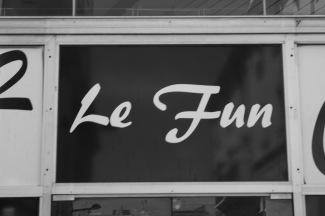 Just what is it about language that we love so much?
Just what is it about language that we love so much?
Why do we enjoy a good neologism? Why do we revel in an arcane expression? Why do we admire a good pun, and love a bad one even more? Why are we possessive about words we think hardly anyone else knows? Why do we worship words, as it were, like “discombobulate” and “whimsy” and “gusset”.
And, why do we praise a good phrase? What is it about a good metaphor, the poetry of Shakespeare, or the catchy rhetorical tropes of a dance show judge? Just what is it that makes us bubble and froth and slobber and cream with joy at even the most everyday of language?
Or to put it another way: why do I write this blog? What is it that language bloggers, book readers, novelists, speech-writers, stand-up comedians, poets, language learners, and lovers of this Fry & Laurie sketch all have in common? Why is it that we humans might feel emotionally drawn to language, beyond its principal function of communication?
By coincidence, the last two novels I read both offered answers. Admittedly, the explanations they offered were as different as the novels themselves.
The first book was Tropic of Capricorn by Henry Miller; the second was I am China by Xiaolu Guo, the tale of a star-crossed Chinese couple and a young British translator, Iona. Guo’s book is a tremendous read for language lovers (more on that in a later blog). Early in the novel, she describes how Iona is drawn to language, especially foreign ones, and how language offers her a way of connecting with others:
“To delve into words, to live with them circling in her mind, allows her to regain something of her life. Perhaps this, most of all, is what enables her to connect. As a teenager, driven crazy by the boredom of living on a small Scottish island inhabited largely by sheep, she found herself longing for foreign words: the alien sounds, the unknown syllable, the mysterious sign. Learning languages consumed her. She stuffed herself full with them, and went to university for more. Perhaps a foreign language would offer her an escape. At school everyone teased her about acting because of her striking resemblance to Hollywood actress Winona Ryder, but shy Iona never saw herself as an actress. She retreated into words.”
In Tropic of Capricorn, Miller has a different – and characteristically more visceral – explanation for his relationship with words:
“‘I love everything that flows,’ said the great blind Milton of our times. I was thinking of him this morning when I awoke with a great shout of joy: I was thinking of his rivers and trees and all that world of night which he is exploring. Yes, I said to myself, I too love everything that flows: rivers, sewers, lava, semen, blood, bile, words, sentences.”
As I read the passages, I didn’t think either really summed up what it is that I love about language, although I could see something in what Guo writes about the “mysterious” and exotic sign. But the two books did get me thinking about the question of why we might be emotionally drawn to words and sentences, vowels and consonants, and just what other explanations there might be.
Have we as human beings evolved to “enjoy” language to some degree and, if so, why? For example, does it facilitate or accelerate – or is it even a requisite for – the learning of our first language? Language is a semiotic system. It involves things and signs (such as sounds or scribbles on a page) to represent those things. So, is it really the things we love – the concepts? Or is it the representations of those things? Is our love of spoken language about aural pleasure (or “sound-sex” as Stephen Fry so aptly puts it) like it is for music? And is our love of written language about visual pleasure – enjoying the printed sign like a painted landscape?
Or is our love of language about things that flow, as Miller suggests? Is it something about transience and streams of ideas? Or is it about a taste of the exotic, like it is for Guo’s protagonist? Are words a mean of escape? Or is language something that connects us deeply with other people, and with ourselves?
I’m sure there are many possible answers and, no doubt, an exploration of them all would provide the material for a long and very interesting book.
A book filled, of course, with pages upon pages of wonderful language.

![“Dance” by Henri Matisse, The Hermitage, St Petersburg [photograph by the author]](https://languagejazz.wordpress.com/wp-content/uploads/2015/09/danse.jpg?w=300&h=208)